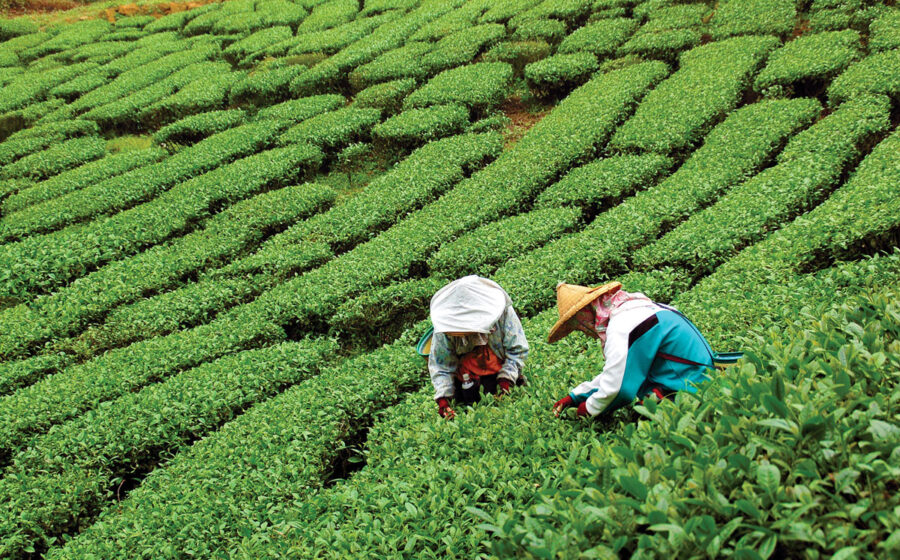[I]t’s true: tea-lovers revel in a world of ritual and constancy, but in fact, tea itself is as ephemeral as anything else that grows. The seasons of tea are many and change from climate to climate, tea to tea. For those who are particular to the thrill of early-harvested teas, each major tea region has its own esteemed first-picking seasons, which produce teas revered for the unique flavor profiles that come from these young, lively buds. And if you’ve been waiting a whole year for these seasons to come back around, it’s even more exciting.
When the buds and leaves of the tea plant are harvested early and with care they can constitute some of the highest prized, praised, and priced teas of the year. But each harvest of new growth—known as a “flush”—has its own character. Precisely when and how long these harvest phases may transpire is at the mercy of climate and weather, of course, as with anything agricultural. In anticipation of a delicious year to come, we turn to China where the first flushes of the year will begin a cycle of tea seasons that will unveil its pleasures throughout the year.
When the buds and leaves of the tea plant are harvested early and with care they can constitute some of the highest prized, praised, and priced teas of the year.
In China, the earliest harvest period of the year is demarcated (not really for any agricultural reason) by teas harvested in March or early April in advance of the Qingming festival, which takes place on or around April fifth according to the solar calendar. The festival of Qingming, which translates essentially to pure brightness, is also known as “tomb sweeping day,” a day of respect to ancestors and others deceased. Teas harvested before Qingming typically bear the Ming Qian, or “pre-Qingming” designation, and are rare due to the extremely short harvest window—which can range from a few weeks to around ten days—between bud readiness and the arrival of the fifth of April. Hallmarks of these teas are the tender buds which yield a range of complex and delicate flavors—from tea to tea these may be more vegetal, floral, or grassy than the later-harvest expressions of the same plants. They may contain a richer concentration of nutrients like amino acids and a lower concentration of astringent-tasting catechins than later pickings. Ming Qian teas account for a small but important percentage of China’s annual harvest.
Early spring harvests of Longjing, translated to dragon well, a green tea grown in the area around Longjing Village near Hangzhou in Zhejiang Province, are known for small, uniform buds with one or two leaves yielding a smooth, characteristically chestnut quality in the cup. Dragon Well is one of China’s so-named Famous Teas, traditional Chinese teas noted as superior by the country’s tea experts. Ming Qian pi luo chun, or green snail spring, is another green Famous Tea known for superior flavor at its earliest harvest. Originating from Jiangsu Province, though the style has travelled, pi luo chun is a highly aromatic tea, known for an unusually fruity and creamy flavor profile. Its hand-twisted leaves are finicky to brew, but the supposed influence of the tea’s neighboring fruit trees is not to be missed.
A white tea from China that shines in earliest spring is yin zhen, translated to silver needles. A tea once reserved for the aristocracy, now these downy, honey-sweet buds are available to all who can purchase them. Like the early spring greens mentioned above, silver needles can lend itself beautifully to repeated infusions.
What’s next? These Ming Qian teas are followed by the Yu Qian harvest season, known as pre-harvest rains, which take place until around April 20. After that, spring tea harvest and late spring tea harvest, followed by whatever may emerge in summer and even into fall, as green teas begin to share the landscape with abundant harvests of black and oolong styles.
Are the earliest pickings of a tea truly the best? It’s a matter of taste, of course. For those who favor those new, gentle, sweetly herbaceous notes, it’s the best time of year to taste teas, including those picked on Chinese slopes. And there’s something thrilling about savoring the buds and leaves from the first harvest of a year. It’s as if the excitement and celebration of these plants’ reawakening somehow translates directly to the cup. If you’re able, this year, seek out some of the first-flush harvests of teas you already know and love, and enjoy the tender moments of their youth with renewed appreciation.
—Liz Clayton is a writer, photographer, and aspiring marmalade chef based in Brooklyn. Liz is associate editor of sprudge.com and author of the book Nice Coffee Time.
















